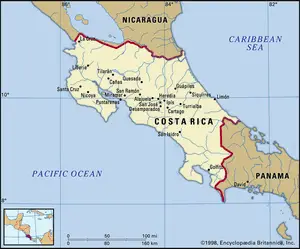Costa Rican Holidays.
Costa Rica observes a total of eleven national public holidays. Nine of them are paid holidays. These holidays hold significant importance in labor law and the Costa Rican culture. We celebrate various historical, cultural, and religious events that have shaped the country’s identity.
New Year´s Day (Año Nuevo):
The year begins with New Year’s Day (Año Nuevo) on January 1, marking the first day of the Gregorian calendar. In Costa Rica, “Año Nuevo” refers to New Year’s Day, celebrated on January 1st. Like many places worldwide, it’s a time for new beginnings and is marked by family gatherings, celebrations, and often fireworks. The night before, on December 31, Costa Ricans enjoy “Noche Vieja” (New Year’s Eve). Festive meals, music, and traditional customs welcome the coming year.
Costa Ricans have unique traditions for Año Nuevo, including: “Agüizotes”. These are local customs believed to bring good luck. Have you ever heard about walking around the block with an empty suitcase? It´s supposed to attract travel opportunities in the coming year. This is an example of an “aguizote”. New Year’s Day is more relaxed as people recover from the previous night.
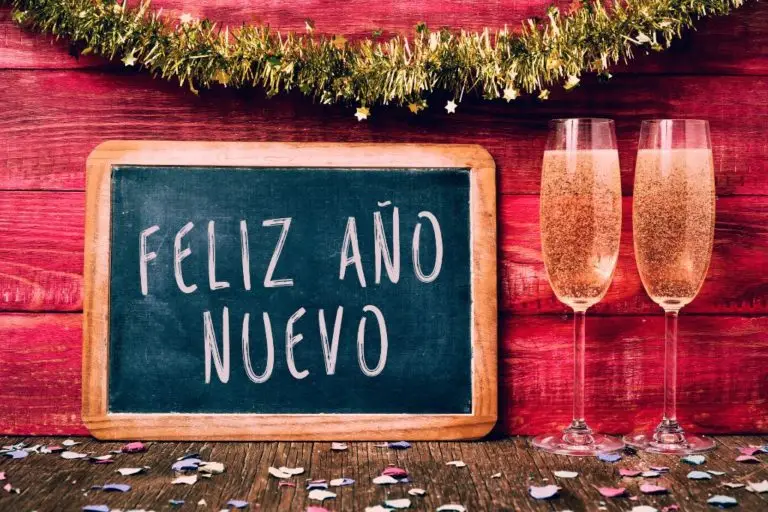
Semana Santa or Holy Week:
Holy Week includes Thursday (Jueves Santo) and Good Friday (Viernes Santo), observed reverently. In Costa Rica, Semana Santa (Holy Week) is one of the most important religious observances. It commemorates the events leading up to Easter, including the crucifixion and resurrection of Our Lord Jesus Christ. It usually spans Palm Sunday to Easter Sunday. Maundy Thursday (Jueves Santo) and Good Friday (Viernes Santo) are public holidays in Costa Rica. Many Costa Ricans take time off this week, to observe religious traditions. Others spend time with family, or flock to the beaches for a vacation.
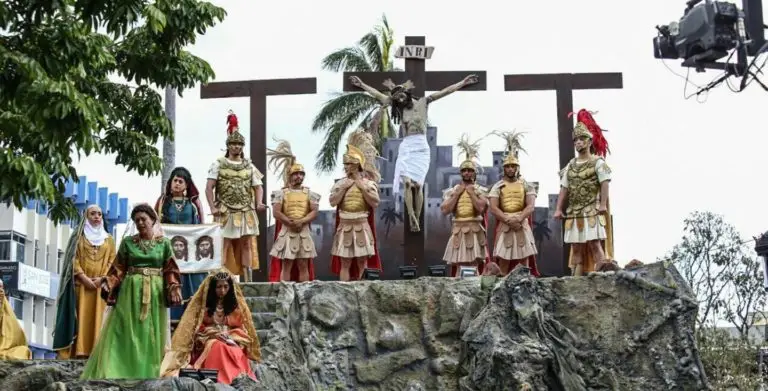
What happens during holy week?
Religious Processions: Many towns and cities host large processions, especially in cities like San José, Cartago, and Heredia. These reenact events from the Passion of Christ, with participants often dressed in biblical attire.
Church Services and Traditions: Costa Ricans attend weekly special Masses and religious services. Churches are often decorated, and priests deliver sermons emphasizing faith, sacrifice, and redemption themes.
Customs and Food: Traditional foods are essential to Semana Santa, especially since many Costa Ricans avoid meat on Fridays as a form of religious observance. Dishes often include seafood, such as ceviche and fish stew, along with traditional treats like empanadas de chiverre (a type of pumpkin empanada), rice pudding, and tamales.
Travel and Family Time: Semana Santa is a popular time for Costa Ricans to travel, either to beaches, mountains, or family gatherings. The country experiences a noticeable slowdown as businesses, schools, and government offices close. San José, seems empty for the week. Traffic jams are an issue when heading to the beaches.
Quiet Days: Historically, there were restrictions on alcohol sales and public celebrations on Maundy Thursday and Good Friday. Although these restrictions have loosened, the tradition of quieter, reflective observances continues. Many Costa Ricans avoid loud parties or festivities on these days.
Semana Santa combines religious reverence with family traditions and travel, making it a unique and culturally rich week in Costa Rica.
Juan Santamaría Holiday in Costa Rica:
April 11 is a holiday in Costa Rica. It´s Dia de Juan Santamaría (Día de Juan Santamaría). This national holiday in Costa Rica honors Juan Santamaría, Costa Rica’s national hero. This day commemorates Santamaría’s bravery in the Battle of Rivas in 1856. It was a pivotal moment in Costa Rican history. He played a crucial role in defending Costa Rica from the forces of the American filibuster William Walker, who aimed to establish control over Central America.
Juan Santamaría was a young drummer boy from the town of Alajuela. According to legend, during the Battle of Rivas, Costa Rican forces, led by General José María Cañas, struggled to advance against Walker’s troops. They had taken refuge in a fortified hostel called “El Mesón”.
Juan Santamaría volunteered to approach the building and set it on fire. He was unfortunately killed during this heroic deed. A bold act that helped the Costa Rican army win the battle and ultimately contributed to Walker’s defeat. This battle was a crucial moment in
Costa Rican history, as it marked the country’s successful resistance against Nicaragua´s invasion, led by William Walker. Though Santamaría was killed during this heroic act, his bravery left a lasting legacy in Costa Rican history.
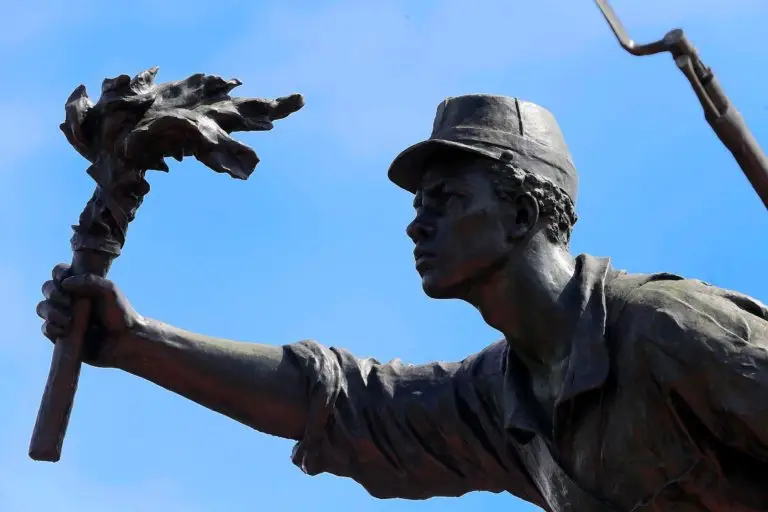
Celebrations and Traditions
Parades and Ceremonies: Parades, speeches, and other public ceremonies are held, especially in Alajuela, Santamaría’s hometown. These events feature traditional music, school bands, and reenactments of the battle to honor his memory.
School and Civic Events: Schools across Costa Rica use the day to teach students about Santamaría’s heroism and the importance of Costa Rican sovereignty. Children participate in events and performances and learn about the battle’s historical significance, ensuring that the legacy of Juan Santamaría is passed on to future generations.
Statues and Monuments: The most famous monument to Santamaría is a statue in Alajuela’s central park, where a large public gathering and ceremonial events take place each year on April 11.
Public Holiday: April 11 is a paid public holiday, meaning most government offices, schools, and businesses close to allow Costa Ricans to participate in or observe the celebrations.
Juan Santamaría Day symbolizes Costa Rica’s values of bravery, patriotism, and the importance of defending national sovereignty, and it remains an essential part of Costa Rican identity.
LABOR DAY (Dia Internacional del Trabajo)
In Costa Rica, Labor Day (Día Internacional del Trabajo) is celebrated on May 1st. Like many countries around the world, this day honors the contributions and achievements of workers and is dedicated to promoting workers’ rights and fair labor practices.
National Holiday: Labor Day is a public holiday in Costa Rica, so most businesses, government offices, and schools close to allow workers to rest and participate in celebrations. Employees are entitled to a paid day off, and those who do work on this day must be compensated at double their regular wage.
How is this holiday celebrated in Costa Rica?
Parades and Rallies: Traditionally, labor unions, workers’ organizations, and political groups organize parades and rallies, especially in San José, the capital. These events focus on advocating for workers’ rights, addressing labor issues, and celebrating the progress made in labor reforms.
Political Speeches and Events: Government officials and union leaders often deliver speeches on Labor Day, addressing current labor issues, economic conditions, and workers’ rights. These speeches can include announcements or discussions on policies affecting labor laws, social security, minimum wage, and workers’ benefits.
Family and Community Gatherings: For many Costa Ricans, Labor Day is also an opportunity to relax with family and friends. It’s common for people to spend the day at home or enjoy outdoor activities, given the holiday’s significance as a day of rest.
The Anexation of Guanacaste. (De la Patria por Nuestra Voluntad.)
The Annexation of Guanacaste (Anexión del Partido de Nicoya) is celebrated on July 25 yearly in Costa Rica. This holiday commemorates the historical event in 1824 when the region of Nicoya, which is now part of the Guanacaste Province, chose to become part of Costa Rica instead of Nicaragua. The annexation is celebrated as a symbol of unity and cultural pride, especially in Guanacaste.
Historical Background
The region, known as the Party of Nicoya, was an administrative district during the Spanish colonial period. Its residents held strong economic and social ties with Nicaragua and Costa Rica. Still, in 1824, following Central America’s independence from Spain, the leaders of Nicoya held a referendum to decide whether to join Costa Rica or remain with Nicaragua. The people of Nicoya voted to annex themselves to Costa Rica, a decision accepted peacefully by all parties involved.
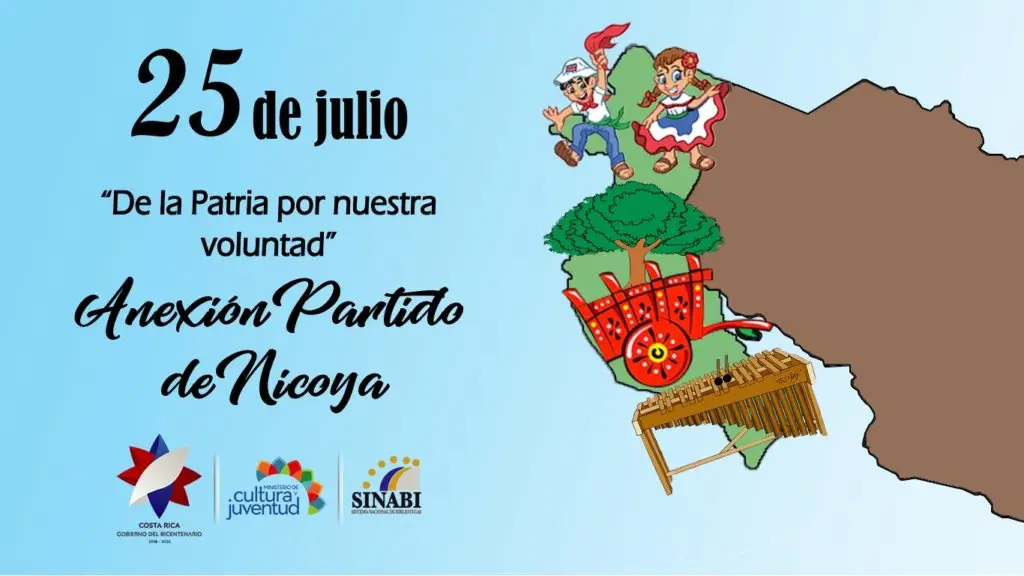
Significance of Guanacaste´s Annexation:
The annexation was significant for several reasons:
Cultural Enrichment: The people of Nicoya brought unique traditions, music, cuisine, and folklore, which have since become an integral part of Costa Rican culture.
Territorial Expansion: The addition of Nicoya expanded Costa Rica’s borders, providing access to the Pacific coastline and new fertile lands.
Economic Contributions: The region’s agricultural resources, especially cattle farming, became valuable assets to Costa Rica’s economy.
Significance of the Holiday
For Costa Ricans, especially those in Guanacaste, the annexation symbolizes the values of self-determination, cultural unity, and respect for democratic choices. It also reflects Costa Rica’s peaceful history and strong regional identities. The holiday is a national symbol of Costa Rican pride, celebrating the unique contributions of Guanacaste to the nation’s identity.
How is this holiday celebrated in Costa Rica?
The Annexation of Guanacaste is celebrated with various festivities, particularly in the Guanacaste Province, where cultural pride runs deep. Celebrations include:
Traditional Dances and Music: Events feature traditional marimba music, dances like the folkloric Punto Guanacasteco, and performances by local groups showcasing Guanacaste’s cultural heritage.
Parades and Rodeos: Colorful parades and rodeos are common, especially in towns like Liberia. These events highlight Guanacaste’s cowboy culture and livestock heritage.
Typical Foods: Food plays a central role in the celebrations, with dishes such as gallo pinto, tortillas, arroz de maíz, and chorreadas (corn pancakes) reflecting the region’s culinary traditions.
School and Civic Ceremonies: Schools hold special events to educate students about the significance of the annexation, fostering a sense of historical pride.
Dia de Nuestra Señora de los Angeles (Our Lady of Angels)
This day is dedicated to Our Lady of the Angels (Nuestra Señora de los Ángeles), the patron saint of Costa Rica. It is one of the country’s most important religious holidays. The holiday centers around the Basilica of Our Lady of the Angels in Cartago, Costa Rica’s former capital, where a revered statue of the Virgin Mary, known as “La Negrita,” is housed.
Historical and Religious Significance
The origin of this holiday dates back to 1635, when, according to legend, a young indigenous girl named Juana Pereira found a small statue of the Virgin Mary on a rock near a spring in Cartago. She took the statue home, but the next day, it mysteriously reappeared at the same spot. This happened several times, and locals interpreted it as a divine sign. A shrine was eventually built around the statue, and the location became a pilgrimage site known for miraculous healing and answered prayers. Our Holy Mother, the Lady of the Angels was later declared the patron saint of Costa Rica, and her feast day has been celebrated annually since then.
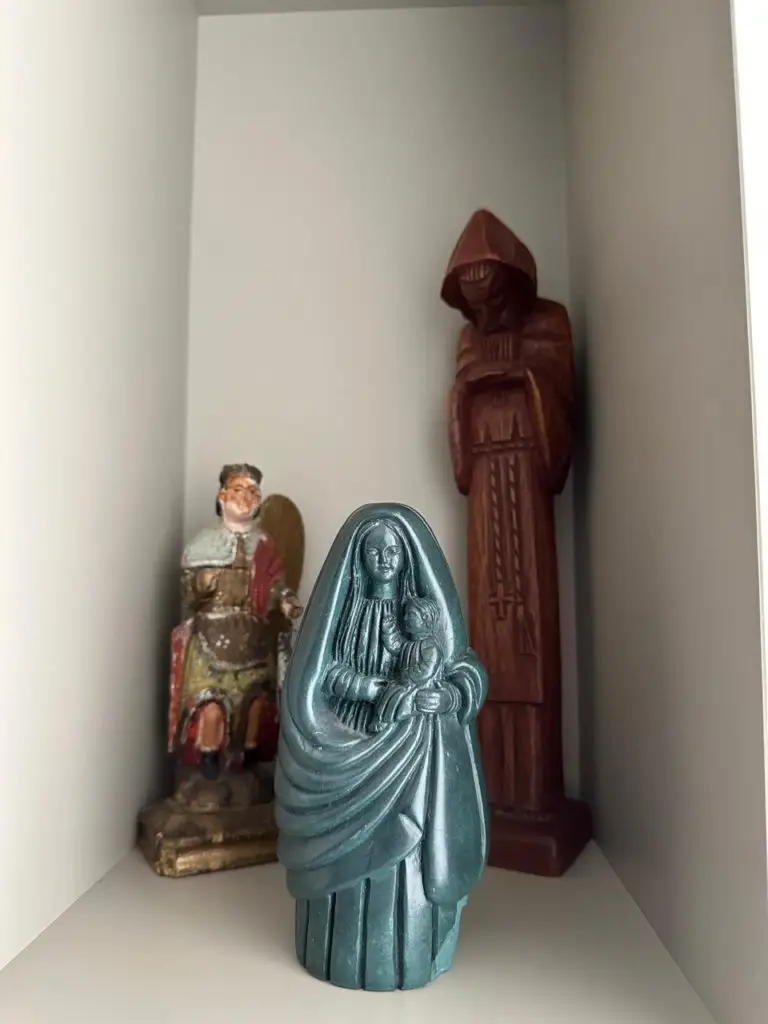
La Romería: A pligrimage of Faith to the Basilica in Cartago.
One of the most distinctive aspects of this celebration is the pilgrimage, or “romería,” where thousands of Costa Ricans from across the country journey, often on foot, to the Basilica in Cartago. The pilgrimage is an act of devotion, penance, and gratitude, with many walking long distances or even from neighboring countries like Nicaragua.
The Route: Pilgrims travel along the main highways and streets, with many walking the final few kilometers on their knees as a gesture of devotion. The journey covers diverse terrain, and people of all ages participate.
Personal Intentions and Gratitude: Many pilgrims make the journey in gratitude for blessings or as a request for protection or healing. It is common for pilgrims to leave offerings or notes at the shrine.
Mass and Celebrations at the Basilica: On August 2, the Basilica hosts a special Mass attended by thousands of devotees, government officials, and religious leaders. The celebrations are filled with hymns, prayers, and offerings to honor “La Negrita.”
National and Cultural Importance:
Día de Nuestra Señora de los Ángeles is a religious event and a powerful expression of Costa Rican identity and unity. The pilgrimage to Cartago brings together people from all backgrounds in a display of shared faith and tradition. While it is not a public holiday that requires businesses to close, many people are given time off to participate in the pilgrimage or attend Mass. For Costa Ricans, this day symbolizes faith, gratitude, and the country’s devotion to its cultural roots.
Mother´s Day: a special holiday in Costa Rica.
In Costa Rica, Mother’s Day (Día de la Madre) is celebrated on August 15, coinciding with the Catholic Feast of the Assumption of the Virgin Mary. It is a significant national holiday dedicated to honoring mothers and their contributions to family and society. Mother’s Day is recognized as a paid public holiday, meaning most businesses and government offices close to allow families to celebrate together.

Traditions and Celebrations of Mother´s Day:
Family Gatherings: Mother’s Day in Costa Rica is primarily celebrated with family gatherings. Children and relatives often come together to prepare meals, spend quality time, and honor the mothers and grandmothers in their families.
Gifts and Flowers: Giving gifts and flowers, particularly roses, is famous for showing appreciation. Jewelry, perfumes, and handmade crafts are common gifts, cards, and personalized messages expressing love and gratitude.
Special Meals: Families typically prepare a special meal to celebrate the day, often featuring traditional Costa Rican dishes such as arroz con pollo (chicken and rice), tamales, or casados (a plate with rice, beans, plantains, and protein). Some families choose to dine out, and many restaurants offer Mother’s Day specials.
School and Church Events: Many schools organize performances or events leading up to Mother’s Day, where children present songs, poems, or dances for their mothers. Additionally, churches often hold special Masses to celebrate and bless mothers, aligning with the religious observance of the Assumption.
Government Recognition: Mother’s Day is a paid holiday in Costa Rica, reflecting the day’s importance in Costa Rican culture. Public offices, businesses, and schools close, and the day is respected as a time for families to unite.
Dia del Niño (Children´s Day):
In Costa Rica, Día del Niño (Children’s Day) is celebrated on September 9. This day is dedicated to honoring children and raising awareness about their rights and well-being. While it is not a public holiday, Día del Niño is widely celebrated nationwide, with schools, communities, and families organizing events and activities for children.
Background and Purpose
Día del Niño is rooted in Costa Rica’s commitment to children’s rights and welfare. The celebration aligns with international efforts to protect and promote children’s rights, reflecting Costa Rica’s dedication to creating a safe and nurturing environment for its youngest citizens. The day serves as an opportunity to educate children and adults about the importance of children’s rights, including access to education, healthcare, safety, and freedom from abuse.

Celebrations and Activities:
School Activities: Schools across Costa Rica celebrate Día del Niño with special events like parties, games, and performances. Teachers often organize fun activities; children may dress up in costumes, dance, or enjoy storytelling sessions. Schools also use the day to educate children on their rights and responsibilities.
Community Events: Many communities hold public celebrations, including parades, fairs, and concerts specifically for children. Parks and public spaces are often filled with activities like face painting, puppet shows, and games.
Gifts and Treats: It’s common for children to receive small gifts or treats from their families, such as toys, candies, or special outings. Some businesses and stores offer promotions on children’s items, and restaurants may provide free meals or discounts for kids.
Government and Nonprofit Involvement: The Costa Rican government and various nonprofits organize programs and campaigns on Día del Niño to raise awareness about children’s welfare issues. Organizations might host educational workshops, provide healthcare services, or run awareness campaigns on issues affecting children, such as child abuse prevention and access to education.
Significance in Costa Rican Society
Día del Niño reflects Costa Rica’s dedication to its children and emphasizes the country’s values of nurturing, educating, and protecting future generations. The day celebrates children and serves as a reminder of the nation’s commitment to upholding and advocating for children’s rights. It highlights Costa Rica’s focus on creating a society that values and protects the well-being of all its youth.
Dia de la Independencia (Independence Day):
Independence Day (Día de la Independencia) in Costa Rica is celebrated on September 15. This day marks Costa Rica’s independence from Spanish rule, declared in 1821 along with the rest of Central America. Independence Day is one of the most important national holidays, celebrated with patriotic fervor and vibrant traditions that highlight Costa Rica’s cultural identity and history.
Historical Background
On September 15, 1821, after more than 300 years of Spanish colonial rule, Costa Rica and other Central American countries (Guatemala, Honduras, El Salvador, and Nicaragua) declared their independence from Spain. News of independence reached Costa Rica several weeks later, as communication was slow. Still, the announcement marked the beginning of a peaceful transition to independence, reflected in Costa Rica’s enduring values of peace and neutrality.

Independence Day Celebrations:
Torch of Freedom (Antorcha de la Libertad): The celebrations begin on the evening of September 14 with the symbolic arrival of the “Torch of Freedom.” This torch is carried in a relay from Guatemala through each Central American country, symbolizing the spread of freedom across the region. The torch is honored in Costa Rica, and students and officials participate in lighting ceremonies nationwide.
Lantern Parade (Desfile de Faroles): On September 14, children participate in the Desfile de Faroles (Lantern Parade), carrying homemade lanterns to symbolize the anticipation of independence. The lanterns, often beautifully decorated in patriotic colors and themes, represent the light of freedom and are held in parades organized by schools and communities.
Parades and Bands: On September 15, schools, community organizations, and government offices organize parades featuring marching bands, traditional dancers, and students dressed in traditional attire. The parades are held throughout the country, with the most significant celebration in the capital, San José. Performers showcase folk dances and play traditional Costa Rican music, celebrating the nation’s cultural heritage.
Patriotic Symbols: Costa Ricans proudly display the national flag and other patriotic symbols on Independence Day. Red, white, and blue decorations adorn homes, schools, and public buildings. The national anthem is sung in schools and public ceremonies: national pride and unity.
Official Speech and Flag-Raising: In San José, government officials, including the President of Costa Rica, participate in a flag-raising ceremony and deliver speeches about the significance of independence, the country’s achievements, and the importance of unity and peace.
Importance of Independence Day for Costa Rican Culture:
Independence Day in Costa Rica is a celebration of freedom from colonial rule and a reflection of the country’s values of peace, democracy, and cultural pride. Unlike many nations that gained independence through war, Costa Rica’s journey to freedom was achieved peacefully, and this legacy has shaped its reputation as a peaceful and stable nation in Latin America. The holiday is a time for Costa Ricans to reflect on their history, honor their cultural heritage, and celebrate the values that unite them as a nation.
Army Abolition Holiday:
Día de la Abolición del Ejército (Army Abolition Day) is celebrated on December 1 in Costa Rica. This unique holiday commemorates Costa Rica’s historic decision in 1948 to abolish its military, which has become a defining aspect of the country’s identity and commitment to peace.
Historical Background
On December 1, 1948, shortly after a civil war and under the leadership of then-President José Figueres Ferrer, Costa Rica officially abolished its army. This decision was symbolically announced in a speech by Figueres at the Bellavista Fortress (now the National Museum) in San José, where he declared that Costa Rica would no longer have a standing army. The funds previously allocated to military spending were redirected toward education, healthcare, and social programs, helping to establish Costa Rica as a peaceful, socially progressive country.
The abolition of the army was later enshrined in Costa Rica’s Constitution in 1949, making Costa Rica one of the few countries without a military. Since then, Costa Rica has relied on international diplomacy, its police force, and treaties for defense and has maintained a reputation for peace and stability.
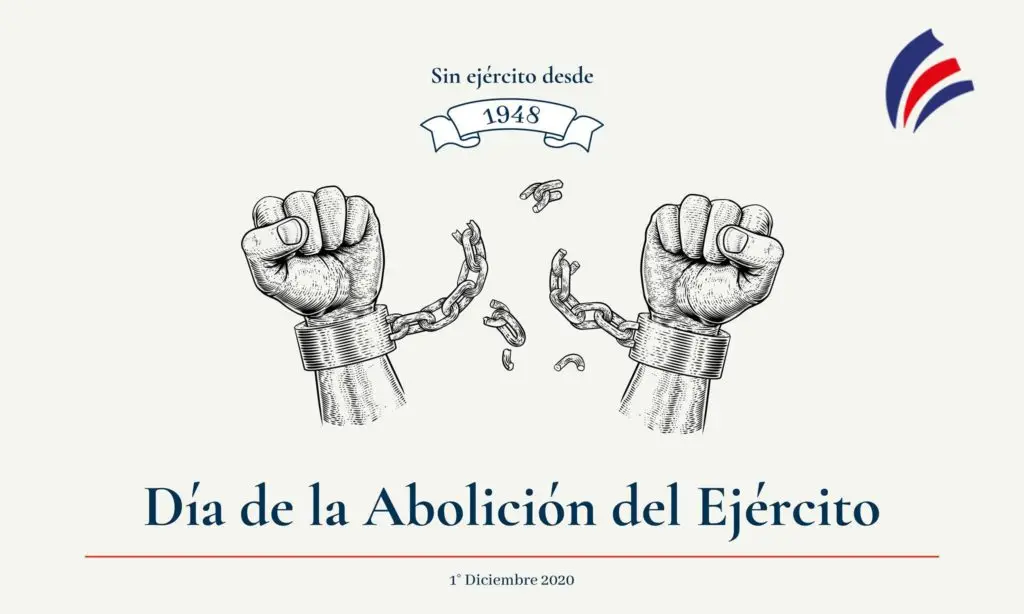
Celebrations for a Country with no Army:
- Ceremonies and Speeches: Government officials, including the President, often participate in public ceremonies and speeches to commemorate the day. These events highlight Costa Rica’s commitment to peace, democracy, and human rights, celebrating the social progress made possible by redirecting military funds.
- Educational Programs: Schools and institutions across Costa Rica use the day to teach students about the importance of peace and the benefits of not having a military. Activities may include discussions, presentations, and projects on the country’s peaceful history and its role in international peace.
- Visits to the National Museum: The Bellavista Fortress, where the abolition was announced, now serves as the National Museum of Costa Rica. Many people visit the museum on this day to reflect on the event’s historical significance and explore exhibits about Costa Rica’s journey toward peace.
Significance of Army Abolition Day
Día de la Abolición del Ejército is a powerful symbol of Costa Rica’s peace, education, and social investment values. By abolishing its military, Costa Rica has been able to focus on social development, which has contributed to its high quality of life, extensive educational system, and excellent healthcare services. The day serves as a reminder of the country’s unique path and commitment to peaceful resolution, making Costa Rica a notable example of peace and diplomacy on the global stage.
Christmas (Navidad):
In Costa Rica, Christmas (Navidad) is a cherished holiday celebrated with a blend of religious traditions, family gatherings, festive foods, and colorful decorations. Christmas in Costa Rica is a season-long celebration with unique customs reflecting the country’s warmth, hospitality, and vibrant culture.

Special ways to celebrate the Nativity in Costa Rica:
Las Posadas: Christmas festivities often begin with Las Posadas, a series of gatherings reenacting Mary and Joseph’s search for shelter. Neighbors take turns hosting, singing Christmas carols, and sharing food. This tradition builds community and prepares for the arrival of Christmas.
Misa de Gallo (Midnight Mass): On Christmas Eve, many Costa Ricans attend Misa de Gallo, or Midnight Mass, which is one of the most essential religious services of the season. Churches across the country are filled with families celebrating the birth of Jesus, followed by prayers, singing, and blessings.
El Portal (Nativity Scene): Creating elaborate nativity scenes, known as “el portal”, is a popular tradition. These displays often depict not only the manger scene but also elaborate settings and landscapes with figurines of animals, villagers, and even Costa Rican elements like ox carts. Families take pride in their nativity scenes, usually set up at the beginning of December.
Decorations and Christmas Trees: Many Costa Ricans decorate their homes with Christmas lights, wreaths, and ornaments. A traditional árbol de Navidad (Christmas tree) is expected, decorated with colorful lights, ribbons, and handmade ornaments. Poinsettias, flor de Navidad, are also widely used as festive decorations.
Other things to look for:
Food and Festive Meals: Christmas is a time for special foods in Costa Rica. One of the most traditional holiday dishes is tamales, made from corn dough stuffed with pork, chicken, rice, and vegetables, wrapped in banana leaves, and steamed. Tamales are often made in large batches, with families coming together to prepare and enjoy them. Other popular Christmas foods include rompope (Costa Rican eggnog), roast pork, pastries, and queque navideño (Christmas fruitcake).
El Tope and Festival de la Luz: After Christmas Day, the holiday season continues with traditional festivals. El Tope is a famous horse parade held on December 26 in San José, where riders showcase their best horses in a lively celebration. Festival de la Luz, a parade of lights held before Christmas in San José, features floats, music, and fireworks, drawing crowds to celebrate with vibrant colors and joy.
New Year’s Celebrations: Costa Ricans continue celebrating through the New Year with family gatherings and fireworks. On New Year’s Eve, families often hold a festive dinner, and fireworks light up the skies across Costa Rica at midnight.
The Christmas Spirit in Costa Rica:
Christmas Day is usually a quieter day spent with family, where loved ones come together for a meal and exchange gifts. Costa Ricans traditionally open gifts on Christmas Day rather than Christmas Eve. Santa Claus, known locally as Colacho or Niño Dios (Child Jesus), is part of the gift-giving tradition, especially for children.
Christmas Spirit in Costa Rica
Christmas in Costa Rica is filled with family, faith, and joy. The holiday embodies Costa Rican values of unity, hospitality, and celebration. From traditional foods and vibrant parades to religious ceremonies and family gatherings, Costa Rica’s Christmas customs bring together friends and families in a warm and festive atmosphere.
Conclusion:
Holidays in Costa Rica are celebrations that reflect the country’s rich cultural heritage, strong family values, and deep sense of community. From religious observances like Semana Santa and Día de Nuestra Señora de los Ángeles to patriotic holidays like Independence Day and Juan Santamaría Day, each holiday is celebrated with a unique blend of tradition, festivity, and national pride. These occasions bring us together to honor our history, faith, and shared values, making holidays an essential part of Costa Rican life and identity.
Dr. Christopher Pirie Gil.
